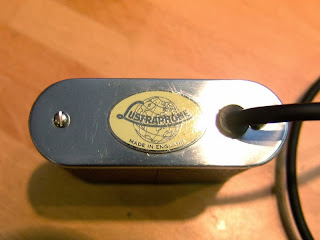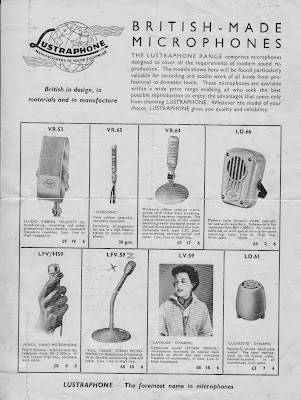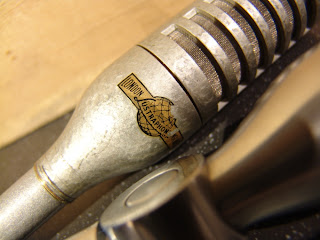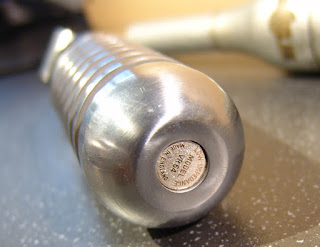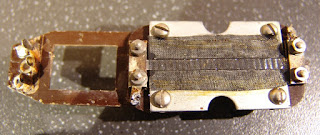Tag: Lustraphone
Yuchain Wang, musicial and producer from New Taipei City in Taiwan, shared this cover version of Joni Mitchell’s ‘A case of you‘.
The vocals were recorded using an upgraded Lustraphone VR53 ribbon microphone. I fitted the microphone with new ribbon and magnets. The Lustraphones are a bit notorious for having a weak output signal and a very dark tone, but the changes make a big improvement to their usability.
You can read more about the magnet upgrades in a previous post.
Lustraphone VR53 upgrade
It has been a long time since my last blog post!
This is mainly because the launch of Extinct Audio took up much more of my time and energy than I had ever imagined. But I have missed this blog and will be posting a bit more often in the coming weeks and months. Thanks for your support.
 |
| Lustraphone VR53 ribbon microphone |
This week I have been working on a few Lustraphone VR53 ribbon microphones. I have never been very enthusiastic about these mics because generally they have a weak output and can sound dark and flabby. Replacing the ribbons and transformers will get the mic so far, but they never quite get up to the performance of other British ribbon mics like the Reslos and Grampians. Which is a shame because they have a unique vintage design and look as though they should be good!
Part of the problem is the magnetic circuit. The two horseshoe magnets provide the field which is conducted (rather inefficiently) around a steel structure to the ribbon. This gives a field around 1500 to 2000 gauss. (For comparison, the field in a healthy Reslo would typically be around 4000 gauss.)
 |
| Milling the pole pieces to make room for new magnets. |
The steel pole structure is the limiting factor here and so swapping the horseshoe magnets gives only marginal improvements. For this upgrade I made a decision to mill out the pole pieces and fit some strong magnets right next to the ribbon.
The difference is impressive, bringing the field across the ribbon to 6000 gauss, which should provide about +9 to +12dB increase in output voltage. With a new ribbon fitted. the output and signal to noise were improved overall by 20dB. Now it can give the other microphones a good run for their money.
 |
| Before and after… new magnets and ribbons. |
As an aside, the stock 200 ohm transformer in this example is actually pretty good and don’t need to be replaced. The 30 ohm and high impedance models are not very well suited to a modern studio and in those cases it is worth swapping them out for a more sensible tranny.
You can read my earlier post about the Lustraphone VR53 microphones here.
Lustraphone Lustrette – dynamic mic
Here is a little Lustrette LD/61 – a charming little egg-shaped desk microphone by Lustraphone.
I picked this one up with a couple of crystal microphones, and for a long time I had wrongly assumed this to be a crystal too. But when I opened it up I found a dynamic capsule and step-up transformer. I should have guessed from the model number – ‘D’ usually means dynamic. In fact it features in a Lustraphone product catalogue that I posted earlier – so I have no excuses!
 |
| Lustraphone LD/61 inside |
The mic comes in a stylish box, with a picture of the mic, so you know what you’re getting.
The dynamic element looks similar to the one found in the more common C51 model, and it is possibly the same mic in a different package.
The Dead Zone….
Here is some amusing copy from the box of a Grundig GRM1, a.k.a. Lustraphone VR53. Above the nice diagram of the the figure 8 pattern, it proudly states “There is virtually no sensitivity at right angles to the microphone front, and this we call the “Dead Zone”. Now we know what to call it!
The Xaudia blog has also been a bit of a dead zone in recent weeks, due to lots of repair work coming in. Things are getting back under control, so more microphone related posts and info will be coming soon!
Lustraphone desk mic or speaker?
This was sold as a desk microphone, but it may actually be a small speaker. Or both! It looks very stylish, with tolex covering and brushed nickel finish.
The ‘device’ measures 600 ohms at 1KHz, and 50 ohms at 100 Hz. Inside, the dynamic element looks more like a small speaker than a mic element, although of course the two things are fundamentally the same technology. When wired as a mic it is pretty lo-fi with a narrow bandwidth. And it does transmit as a speaker too. My guess is that it was part of an intercom system and serves both purposes.
Whatever the intended purpose, one can easily imagine this on a gentleman’s desk, so that he could talk to his secretary whilst smoking a pipe and considering important, worldly matters… like this chap!
Lustraphone Badges in stock!
I see a lot of Lustraphone VR53 mics around that have lost their original badges – like the ones on the left and right. The glue that was used wasn’t great, and they look rather sad without their original nameplate.
 |
| Replacement Lustraphone badge |
I am delighted to say that we have just taken delivery of some replacement badges for these that look absolutely fabulous. They have a silver logo on a vintage cream background, just like the originals.
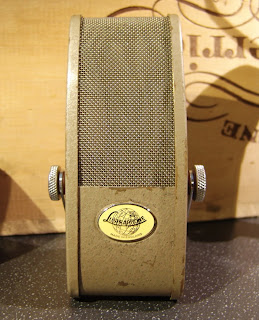 |
| Lustraphone VR53 with new badge! |
They of course also fit the Grundig, Pamphonic and Mimco badged versions of the VR53, and also some of the small Lustraphone dynamics too.
 |
| Lustraphone dynamic with new badge! |
The badges are £5 each plus post from the Xaudia website.
(Thanks to Best Badges for their excellent service!)
Lustraphone microphone catalogue
With a typically British quirkiness, the price of the VR65 stereo ribbon is given as 30 Guineas rather than pounds, shillings and pence. A guinea was equivalent to one pound and one shilling, so at about 4 times the cost of the mono VR64, the stereo VR65 was a very expensive mic!
In other Lustraphone related news, I have commissioned a batch of replacement enamel badges for Lustraphone VR53 and other microphones. They will be available through the Xaudia website very soon.
MOTM – Lustraphone VR64 ribbonette
Lustraphone was a British manufacturer of audio and hi-fi equipment based on Regent’s Park Road in North West London. They traded from 1942 until sometime in the 1970s, when the company was dissolved. This month’s MOTM is the Lustraphone VR64 pencil ribbon mic, known s the ‘ribbonette’ because of its small size. It was the successor to the VR53. They were also sold under the EAP / Elizabethan brand.
The VR64 is an attractive looking small ribbon mic, with a slightly wider grill at the front than the rear. Like its competition from Reslo and Film Industries, the magnets are positioned to the rear of the ribbon making it an imperfect figure-8 pattern. It was produced in several colours – I have see brushed chrome, blue paint, and grey hammertone examples.
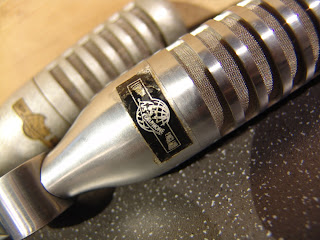 |
| Add caption |
I always thought that Lustraphone had one of the coolest logos, a bit reminiscent of The Man From UNCLE TV series. Different models have different styles of badges, either applied as a decal or a sticker.
When working properly, the VR64 sounds rather good, with a higher output and better top end response that the VR53. Like most of the British ribbons of the time, the Lustraphone mics were available with different impedances. The mics come badged with either ‘High’ or ‘Low’ impedance, but that doesn’t always tell the whole story. Two examples pictured here were both marked low impedance. However, one measured 15 ohms and the other 600 ohms, so it is important to know what you have.
The output transformers have a slight quirkiness, in that the bobbin is pushed halfway through the frame of the mic before the laminations are added, which neatly solves the problem of mounting the tranny.
 |
| Lustraphone VR64 inside |
 |
| Lustraphone VR64 motor – rear view showing magnets |
I’m not sure if having a layer of insulator between the laminations has any sonic effect, beyond the fact that the transformer has one fewer layer of laminations in the stack, and so a lower inductance and higher cutoff frequency. Probably little or none.
The 15 ohm transformer is made up from 15 turns of 0.85 mm wire for the primary, and about 145 turns of 0.3 mm for the secondary, giving a ratio just under 1:10. This one was re-wound for 300 ohms using the original lams, which gives a better output level into a modern preamp, whilst retaining the vintage character.
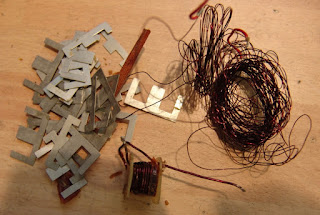 |
| Lustraphone transformer autopsy |
This example had a quick release mounting system. A bullet shaped part screws onto the mic stand, and then the mic is pushed onto it. Very cunning!
 |
| Lustraphone quick release mic mount |
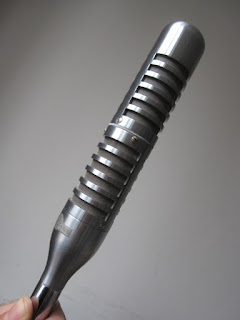 |
| Lustraphone VR65 stereo ribbon mic |
Lustraphone filed a patent for a stereo ribbon mic with a complicated switching system, to reverse phase and reduce noise, although the only examples I have seen have had seperate outputs for each ribbon, and no switches.
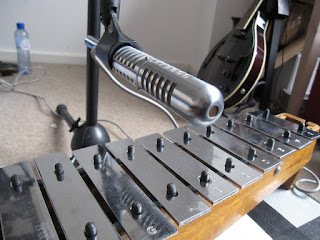 |
| Lustraphone VR65 in action |
Lustraphone VR53 microphone documents
Lustraphone was one of several British companies making microphones back in the 50s and 60s. The catalog includes product sheets for several microphones and also some accessories such as mic stands and matching transformers. I was lucky enough to come across some old Lustraphone catalog pages, which included a product sheet for the VR53 ribbon velocity microphone and several other microphones. The catalog probably dates from 1952 or 1953. Note the four digit phone number!
 |
| Lustraphone VR53 ribbon mic data sheet front |
 |
| Lustraphone VR53 ribbon mic catalog, reverse |
Although the catalog mentions 20 ohm and 500 ohm models, I have also seen high impedance models of this mic. The frequency response is claimed to be “substantially maintained to 14000 Hz”. From experience, I would say that ‘substantially’ is used loosely. The BBC have a bit more to say about this mic in their R&D reports.
As well as the VR53, the catalog also includes
VC52 “velodyne” noise cancelling microphone
C48 moving coil microphone
C51 dynamic microphone
C151 telephone microphone
AGC496a – Automatic gain control, which looks to be some kind of tube limiter.
MOTM – Lustraphone VR53 (a.k.a. Grundig) ribbon mic.
November’s microphone of the month is a British long-format ribbon that was sold under the names “Lustraphone” and ‘Grundig”.
 |
| A Lustraphone-badged ribbon microphone in glorious brushed stainless steel finish |
This mic was available in at least three different impedances, and I have come across 30, 200, and high impedance models. Unfortunately the badge often falls off so you don’t always know what you are getting! Most of the models I have seen are finished in a bronze hammerite colour, although there is a deluxe low impedance model which has a gorgeous brushed stainless steel finish. Despite the different badges and finishes, the mics are exactly the same on the inside (transformer aside).
 |
| Lustraphone ribbon microphones on the bench |
One of the ribbon clamps sits on a spring-tensioned screw thread, which allows fine adjustment of the ribbon tension. This makes tuning the ribbon very straight-forward, and allows the owner a little bit of grace if the ribbon becomes a little stretched over time. This feature should probably be mandatory on all ribbonmics!
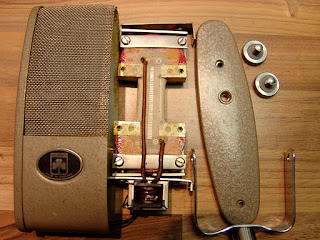 |
| Grundig badged lustraphone mic, opened up for service |
The magnetic field is supplied by a pair of horseshoe magnets (which unfortunately sometimes age with time, losing their strength). Connection to the rest of the world is made by a balanced three-pin paxolin plug, which are hard to come by now. The middle pin is ground, with the audio on the outer two pins.
 |
| Rear connector and original plug. |
Fortunately, a male XLR connector can be modified to fit by slicing off part of the barrel.
 |
| XLR connector modified to fit the mic. |
The long ribbon and motor design gives these mics a full bottom end and a pronounced proximity effect. Here are the frequency plots for three of these mics that we have serviced recently:
 |
| Lustraphone ribbon mic frequency plots. |
(Thanks to Mark Stevens for additional information).
Update 23/1/12. These microphones were also sold under the brand Pamphonic. One appeared recently on ebay:







